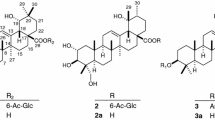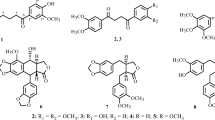Abstract
A minor cytotoxic compound was isolated by bioassay-guided fractionation from Asiasari Radix and identified as aristolactam III (1) on the basis of spectral data and chemical evidence. This is the first report on the isolation of compound1 from Asiasarum genus. Compound 1 exhibited a significant cytotoxic activity against the three kinds of human cancer cell lines (A-549, SK-MEL-2 and SK-OV-3).
Similar content being viewed by others
References Cited
Hashimoto, K., Katsuhara, T., Itoh, H., Ikeya, Y., Okada, M. and Mitsuhashi, H., Monoterpenes from Asiasari Radix fromAsiasarum Sp.Phytochemistry, 29, 3571–3574 (1990).
Hashimoto, K., Katsuhara, T., Niitsu, K., Ikeya, Y., Okada, M. and Mitsuhashi, H., Two glycosides from roots ofAsiasarum sieboldi.Phytochemistry, 31, 2477–2480 (1992).
Hashimoto, K., Yanagisawa, T., Okui, Y., Maruno, M. and Fujita, T., Studies on anti-allergic components in the roots ofAsiasarum sieboldi.Planta Medica, 60, 124–127 (1994).
Houghton, P. and Ogutveren, M., Aristolochic acids and aristolactams fromAristolochia auricularia.Phytochemistry, 30, 253–254 (1991).
Kosuge, T., Yokota, M., Nukuya, H., Goto and Nagasawa, M., Studies on antitussive principles of Asiasari Radix.Chem. Pharm. Bull., 26, 2284–2285 (1978).
Nagasawa, M., Analysis of crude drugs by infrared spectrophotometry. II. Analysis of Asiasari Radix by infrared spectrophotometry.Yakugaku Zasshi, 81, 129–138 (1961).
Priestap, H., Seven aristolactams fromAristolochia argentina.Phytochemistry, 24, 849–852 (1985).
Shougakukan,The dictionary of Chinese drug Vol II., Shanghai Science and Technology Publisher and Shougakukar. Tokyo, pp. 1805, 1985.
Skehan, P., Storeng, R., Scudiero, D., Monks, D., McMahon, J., Vistica, D., Warren, J. T., Bokesch, H., Kenney, S. and Boyd, M. R., New colorimetric cytotoxicity assay for anticancer drug screening,J. Natl. Cancer Inst., 82, 1107–1112 (1990).
Yahara, S., Kato, K. and Nohara, T., Studies on the water soluble portion in Asiasari Radix.Shoyakugaku Zasshi, 44, 331–334 (1990).
Yasuda, I., Takeya, K. and Itokawa, H., Structures of amides fromAsiasarum hetereotropoides Maek. var.mandshuricum Maek.Chem. Pharm. Bull., 29, 564–566 (1981).
Author information
Authors and Affiliations
Rights and permissions
About this article
Cite this article
Park, J.D., Baek, N.I., Lee, Y.H. et al. Isolation of a cytotoxic agent from Asiasari Radix. Arch. Pharm. Res. 19, 559–561 (1996). https://doi.org/10.1007/BF02986028
Received:
Issue Date:
DOI: https://doi.org/10.1007/BF02986028




